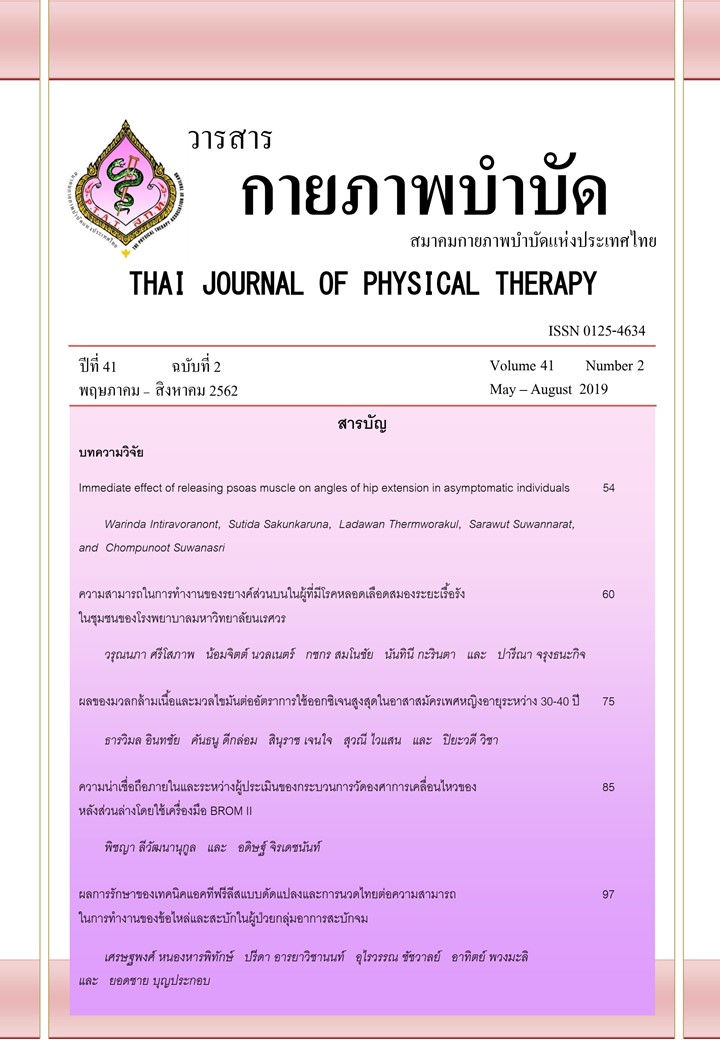ความน่าเชื่อถือภายในและระหว่างผู้ประเมินของกระบวนการวัดองศาการเคลื่อนไหวของหลังส่วนล่างโดยใช้เครื่องมือ BROM II
Main Article Content
บทคัดย่อ
ที่มาและความสำคัญ: Back range of motion instrument (BROM II) เป็นเครื่องมือที่ใช้ในการวัดองศาการเคลื่อนไหวของหลังได้ในทุกทิศทาง เมื่อพิจารณาถึงกระบวนการวัดองศาการเคลื่อนไหวของหลังในแต่ละการศึกษานั้นพบว่า ขั้นตอนของกระบวนการวัดองศา การฝึกการใช้เครื่องมือของผู้ประเมิน และคำอธิบายวิธีการหาตำแหน่งอ้างอิงในการวางเครื่องมือ BROM II ไม่ชัดเจน จึงทำให้การศึกษาถึงความน่าเชื่อถือในการวัดองศาการเคลื่อนไหวของหลังส่วนล่างโดยใช้ BROM II มีค่าสัมประสิทธิ์สหสัมพันธ์ภายในชั้นในการวัดช่วงการเคลื่อนไหวในบางทิศทางที่มีค่าสูง
วัตถุประสงค์: เพื่อศึกษาความน่าเชื่อถือภายในและระหว่างผู้ประเมินของกระบวนการวัดองศาการเคลื่อนไหวของหลังส่วนล่างโดยใช้เครื่องมือ BROM II
วิธีการวิจัย: ผู้เข้าร่วมงานวิจัยทั้งสิ้น 20 คน (ชาย 10 คนและ หญิง 10 คน) และผู้ประเมิน 2 คน ดูคลิปวีดีโอขนาดความยาวประมาณ 4 นาที ประกอบด้วย 3 ตอนคือ (1) การหาตำแหน่งอ้างอิง (2) การกำหนดตำแหน่งท่าทางเริ่มต้น และ (3) การระบุคำสั่งและแสดงท่าทางการเคลื่อนไหวของหลังส่วนล่าง จากนั้นจึงหาตำแหน่งอ้างอิงและกำหนดตำแหน่งท่าทางเริ่มต้น และการวัดองศาการเคลื่อนไหวของหลังส่วนล่างจำนวน 6 ทิศทาง โดยให้คำสั่งในการทำการเคลื่อนไหวที่ชัดเจน เป็นจำนวน 4 ครั้ง สลับกันระหว่างผู้ประเมิน 2 คน โดยการทดสอบทางสถิติใช้แบบจำลอง ICC(3,1) ในการหาความน่าเชื่อถือภายในตัวผู้ประเมินและใช้แบบจำลอง ICC(2,1) ในการหาค่าความน่าเชื่อถือระหว่างตัวผู้ประเมิน
ผลการวิจัย: จากการศึกษาพบว่าความน่าเชื่อถือของกระบวนการวัดองศาการเคลื่อนไหวของหลังโดยใช้เครื่องมือ BROM II อยู่ในระดับดีในทุกทิศทาง โดยพบความน่าเชื่อถือภายในตัวผู้ประเมินคนที่ 1 และ 2 (ICC(3, 1)) อยู่ระหว่าง 0.81 ถึง 0.97 และพบความน่าเชื่อถือระหว่างผู้ประเมิน (ICC(2, 1)) อยู่ระหว่าง 0.77 ถึง 0.88
สรุปผล: กระบวนการวัดองศาการเคลื่อนไหวของหลังส่วนล่างโดยใช้เครื่องมือ BROM II ที่มีการปรับปรุงกระบวนการ พบว่ามีความน่าเชื่อถือในระดับดีในทุกทิศทาง โดยกระบวนการดังกล่าวสามารถนำไปใช้ในงานวิจัยเกี่ยวกับการวัดการเปลี่ยนแปลงของช่วงการเคลื่อนไหวของหลังส่วนล่างได้
Article Details
เอกสารอ้างอิง
2. Merritt JL, McLean TJ, Erickson RP, Offord KP. Measurement of trunk flexibility in normal subjects: reproducibility of three clinical methods. Mayo Clin Proc. 1986; 61(3): 192-7.
3. Reese NB, Bandy WD. Joint range of motion and muscle length testing. St. Louis, Missouri: Saunders/Elsevier, 2002.
4. Teixeira F, Carvalho G. Reliability and validity of thoracic kyphosis measurements using flexicurve method. Rev Bras Fisioter. 2007; 11(3): 173-7.
5. Youdas JW, Suman VJ, Garrett TR. Reliability of measurements of lumbar spine sagittal mobility obtained with the flexible curve. J Orthop Sports Phys Ther. 1995; 21(1): 13-20.
6. Mirbagheri SS, Rahmani-Rasa A, Farmani F, Amini P, Nikoo MR. Evaluating kyphosis and lordosis in students by using a flexible ruler and their relationship with severity and frequency of thoracic and lumbar pain. Asian Spine J. 2015; 9(3): 416-22.
7. Nitschke JE, Nattrass CL, Disler PB, Chou MJ, Ooi KT. Reliability of the American Medical Association guides' model for measuring spinal range of motion: Its implication for whole-person impairment rating. Spine. 1999; 24(3): 262-8.
8. Kachingwe AF, Phillips BJ. Inter- and intrarater reliability of a back range of motion instrument. Arch Phys Med Rehabil. 2005; 86(12): 2347-53.
9. Ng JK, Kippers V, Richardson CA, Parnianpour M. Range of motion and lordosis of the lumbar spine: reliability of measurement and normative values. Spine. 2001; 26(1): 53-60.
10. Breum J, Wiberg J, Bolton JE. Reliability and concurrent validity of the BROM II for measuring lumbar mobility. J Manipulative Physiol Ther. 1995; 18(8): 497-502.
11. Haff, GG and Dumke, C. Laboratory manual for exercise physiology. Champaign, IL: Human Kinetics, 2012.
12. Williams R, Binkley J, Bloch R, Goldsmith CH, Minuk T. Reliability of the modified-modified Schober and double inclinometer methods for measuring lumbar flexion and extension. Phys Ther. 1993; 73(1): 33-44.
13. Yousefi M, Ilbeigi S, Mehrshad N, Afzalpour ME, Naghibi SE. Comparing the validity of non-invasive methods in measuring thoracic kyphosis and lumbar lordosis. Zahedan J Res Med Sci. 2012; 14(4): 37-42.
14. Yanagawa TL, Maitland ME, Burgess K, Young L, Hanley D. Assessment of thoracic kyphosis using the flexicurve for individuals with osteoporosis. Hong Kong Physiother J. 2000; 18(2): 53-7.
15. Brosseau L, Balmer S, Tousignant M, O'Sullivan JP, Goudreault C, Goudreault M, et al. Intra- and intertester reliability and criterion validity of the parallelogram and universal goniometers for measuring maximum active knee flexion and extension of patients with knee restrictions. Arch Phys Med Rehabil. 2001; 82(3): 396-402.
16. Saur PM, Ensink FB, Frese K, Seeger D, Hildebrandt J. Lumbar range of motion: reliability and validity of the inclinometer technique in the clinical measurement of trunk flexibility. Spine. 1996; 21(11): 1332-8.
17. Stovall BA, Kumar S. Anatomical landmark asymmetry assessment in the lumbar spine and pelvis: a review of reliability. PM&R. 2010; 2(1): 48-56.
18. Performance Attainment Associates. BROM 11: Back Range of Motion [brochure 8201 and video]. Roseville, Minn: Performance Attainment Associates; 1992.
19. Madson TJ, Youdas JW, Suman VJ. Reproducibility of lumbar spine range of motion measurements using the back range of motion device. J Orthop Sports Phys Ther. 1999; 29(8): 470-7.
20. Norkin CC, White DJ. Measurement of joint motion: a guide to goniometry. Philadelphia: F.A. Davis Company, 2016.
21. Tousignant M, Morissette J, Murphy M. Criterion validity study of lumbar goniometers BROM II and EDI-320 for range of motion of lumbar flexion of low back pain patients. J Back Musculoskelet Rehabil. 2002; 16(4): 159-67.
22. Bujang MA, Baharum N. A simplified guide to determination of sample size requirements for estimating the value of intraclass correlation coefficient: a review. Arch Orofac Sci. 2017;12(1):1-11.
23. Hoppenfeld S. Physical examination of the spine and extremities. New York: Appleton-Century-Crofts. 1976.
24. McIlroy WE, Maki BE. Preferred placement of the feet during quiet stance: development of a standardized foot placement forbalance testing. Clin Biomech. 1997; 12(1): 66-70.
25. Portney LG, Watkins MP. Foundations of clinical research: applications to practice. 2nd ed. Upper Saddle River: Prentice Hall Health, 2000.
26. Atya AM. The validity of spinal mobility for prediction of functional disability in male patients with low back pain. J Adv Res. 2013; 4(1): 43-9.
27. Mayer TG, Kondraske G, Beals SB, Gatchel RJ. Spinal range of motion. Accuracy and sources of error with inclinometric measurement. Spine. 1997; 22(17): 1976-84.


